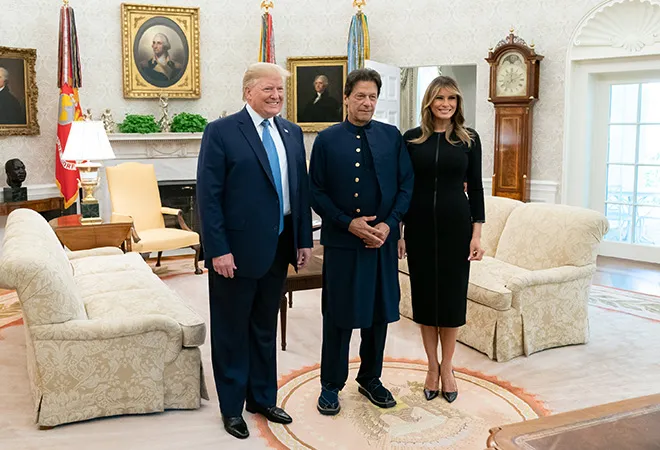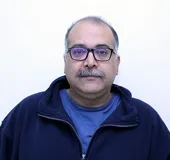-
CENTRES
Progammes & Centres
Location

Three days, and three quite different optics emerging from the same man, leaving everyone scratching their heads, trying to figure how the South Asian cookie is going to crumble, or even if there is a cookie that can crumble. It need not have been this way.
The ‘Howdy Modi’ spectacle in Houston on September 22, followed by the meeting between US President Donald Trump and Pakistan's Prime Minister Imran Khan on the side lines of the UN General Assembly (UNGA) on September 23, which in turn was followed by a similar meeting between Trump and the Indian Prime Minister Narendra Modi on September 24, were not three episodes of a single event but three different events. Analysing them by lumping them was always going to be problematic because the agenda, focus and thrust in each of these events was different even though the dramatis personae might have figured in one or more events.
Trump understood this and therefore his responses in each of the three events were as per the requirements of occasion and the audience. For Trump, the India-Pakistan binary that seemed to obsess everyone in South Asia was at best a sideshow in each of these events, a minefield that he needed to sidestep. He knew what he wanted to project, and extract, from each of these events. Even if the talking heads on TV didn’t get it, Trump knew better than to get ensnared in the Indo-Pak tangle. His solution was to dehyphenate India and Pakistan so that he could deal with them separately and get what he wanted from each country.
For Trump, the India-Pakistan binary that seemed to obsess everyone in South Asia was at best a sideshow in each of these events, a minefield that he needed to sidestep.
The simple fact of the matter is that the US has interests attached to both countries and wasn’t going to jeopardise one for the other. Admittedly, the scale and scope of US relations with India and Pakistan differ vastly. With India, the US is building a relationship which is strategic but also has an important transactional (read economic) dimension; with Pakistan, the US relationship is almost entirely transactional even in the strategic sense – Afghanistan, terrorism, nuclear safety. To put it differently, with India the positive elements in the relationship outweigh and outscore the negatives, while in Pakistan's case, the relationship is based on mostly negatives rather than anything positive. This then is the context in which the three events and the optics emanating from them have to be viewed. This was reflected also in the meetings between the leaders. Modi was relaxed and brimming with confidence, quite comfortable in the presence of Trump, especially at the ‘Howdy Modi’ event. Imran Khan on the other hand had a diffident, even tense, look on his face, and was holding worry beads in his hands during his meeting with the US President.
‘Howdy Modi’ was in every which way a stupendous event. The US President shared the stage with the Indian Prime Minister in front of a massive crowd of nearly 60,000 people to celebrate not just the Indian American community but also maturing of US-India friendship, partnership and strategic relationship, summed up in the tag line “Shared Dreams, Bright Futures”. Trump’s presence completely transformed ‘Howdy Modi’ from being about Modi and his fan following among the Indian Americans, to becoming an extra-ordinary demonstration of US-India bonhomie. Because it was about Modi and Trump, and by extension US and India, both sides laid it real thick on each other, with the two leaders using all possible superlatives to describe not just one and other but also the relations between their countries.
Trump belied all apprehensions of saying something awkward and stuck to the script. Everything he said was music to Indian ears – from trade and investment, to military exercises and defending borders, and fighting ‘radical Islamic terrorism’. But he was also careful to not say anything directly against Pakistan. In fact, the next day Trump clarified that he was referring to Iran and not Pakistan when he spoke about ‘radical Islamic terrorism’. For his part, Modi too didn’t name Pakistan – it seems that was the understanding because the next day during his meeting with Imran Khan, Trump did say that he didn’t know he was going to hear an aggressive statement from Modi at the Houston event – but only the most obtuse person would not know that he was aiming sharp barbs at Pakistan.
Unlike unconventional diplomacy underlying the ‘Howdy Modi’ event, the meetings on the side lines of the UNGA were entirely about conventional diplomacy. From Trump’s perspective, his meeting with Imran Khan wasn’t so much about US-Pakistan relations as it was about Afghanistan and terrorism. Of course, Imran Khan was desperate to drag in Kashmir one way or another, and try and get something out of Trump on this issue. Trump couldn’t outrightly rebuff him on Kashmir because he needs something out of Pakistan on Afghanistan. He therefore dangled the carrot of mediation, even arbitration, but added the caveat that both India and Pakistan had to agree on this. From the time when he claimed Modi asked him to mediate or arbitrate on Kashmir, to now when he has merely restated a traditional US stand that it is ready for mediation provided both parties accepted it, Trump’s outreach has undergone a significant shift.
The huge change in position is clear from the fact that when Trump met Imran the last time in July, the constitutional changes in Jammu and Kashmir had not taken place and the Afghanistan ‘peace talks’ were entering into the final stages. Even at that time, Imran Khan was constantly parroting Kashmir and Trump gave him a bone to chew on. But since then, the Taliban talks been pronounced dead by Trump which leaves Pakistan, which was flying high in July, in a limbo. And what is worse from Pakistan's perspective, the situation in Jammu and Kashmir has undergone a tectonic change and acquired enormous salience. Yet, all Imran could extract from Trump was a mediation offer, albeit with a veto given to India. In other words, the offer he dangled before Imran is enough to give him something, without really taking away anything from India. Unless New Delhi is pathological about the existence or mention of the word mediation, Trump’s remarks in the company of Imran don’t mean anything, either substantively nor symbolically. On other issues such as alleged human rights violations in Kashmir, Trump again avoided wading into a controversy by mumbling something about wanting to see everything work out and wanting it to be humane.
The huge change in position is clear from the fact that when Trump met Imran the last time in July, the constitutional changes in Jammu and Kashmir had not taken place and the Afghanistan ‘peace talks’ were entering into the final stages.
In his bilateral with Modi, Trump did say that Kashmir would be discussed but added that they had plenty of other issues to deliberate on as well. Apart from both leaders singing Paeans for each other yet again, it was clear that the primary focus of the meeting would be on trade issues with Trump expressing confidence that the two sides will be striking a trade deal very soon. Interaction with the media before the meeting however turned the entire conversation to Pakistan and its involvement in terrorism. Instead of focussing on trade issues, or strategic issues like the forthcoming Quad meeting at the foreign ministers level, China, Indo-Pacific, Afghanistan, looming conflict in the Middle East, climate change, the media reduced the entire Indo-US bilateral into a meeting about Pakistan.
Trump of course skilfully sidestepped all the questions implicating Pakistan of promoting terrorism. But he did give Modi a shot in the arm by referring to the ‘pretty loud message’ delivered by Modi to Pakistan in Houston. and added that Modi will handle not only the issue of terrorists infiltrating into India but also solve the problem of ‘Pakistani state sponsored terrorism’. The Indian media’s obsession with hyphenating India with Pakistan however seems to have ensured that the bilateral was reduced to discussing just trade and terrorism (and by extension Jammu and Kashmir), as became clear in the briefing given by the foreign secretary to media personnel.
That India has a Pakistan problem is undeniable. But for India to look at its relationships with other countries, especially friendly Great Powers, from the prism of Pakistan is disastrous diplomacy. While Modi and his team at the Ministry of External Affairs understands this simple fact, it doesn’t seem to be filtering down beyond South Block. From media personnel to politicians, the national obsession with India's neighbour from hell, and the vicarious pleasure drawn from showing it down appears to obscure all other important and critical issues. In the process, we are in perpetual danger of losing the plot of raising India's diplomatic game on the world stage by aiming very low.
The views expressed above belong to the author(s). ORF research and analyses now available on Telegram! Click here to access our curated content — blogs, longforms and interviews.

Sushant Sareen is Senior Fellow at Observer Research Foundation. His published works include: Balochistan: Forgotten War, Forsaken People (Monograph, 2017) Corridor Calculus: China-Pakistan Economic Corridor & China’s comprador ...
Read More +